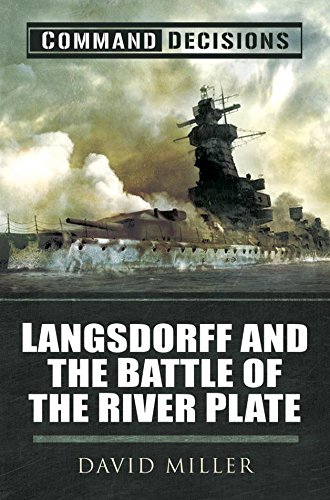
Command Decisions; Langsdorff and the Battle of the River Plate. By David Miller. Pen and Sword Maritime, Barnsley, Yorkshire, reprinted 2021.
Reviewed by Tim Coyle
The Battle of the River Plate of December 1939 and the war cruise of the German Panzerschiff Graf Spee lives to this day as a tragi-drama whose hero, Kapitan Zur Zee Hans Langsdorff is depicted as an honourable naval officer in command of a crack man-of-war. Hunted and wounded in a classic naval action Graf Spee sought temporary shelter to repair action damage and tend to dead and wounded crew in Montevideo where the ship was blown up by its crew under the captain’s direction on the false premise that Royal Navy capital ships were waiting offshore. The continued fascination in this battle is that it was one of the last naval battles in which sub-surface and air forces were not present.
In Command Decisions; Langsdorff and The Battle of the River Plate, author David Millar offers a masterful narrative of the cruise of the Graf Spee, its spectacular self-immolation and the suicide of its commander. Hans Langsdorff scrupulously followed humanitarian and maritime rules of war in carrying out commerce warfare on principles which would soon be subsumed by the brutal U-boat war. Langsdorff ensured his crew tended to the captive merchant crews and won the latter’s respect; in the case of Captain Dove, a warm friendship formed. Langsdorff’s last acts of command were to ensure the welfare of his crew after the Graf Spee’s destruction then, dressed in uniform, lay on the German naval ensign and shot himself.
David Miller gives the reader much more than the Langsdorff/Graf Spee history. He provides a comprehensive historical background of German surface commerce raiding in the First World War and the lessons learnt. Commerce raiding tied down Royal Navy resources and these German ‘force multipliers’ were again pressed into service in 1939 with the new world war.
Among the surface raiders were the intriguing three unit Deutschland-class ‘panzerschiff’, known popularly in English as ‘pocket battleships’. Designed to the 10000 ton Washington Treaty cruiser limitation (although likely to have been over 2000 tons heavier), with the maximum practical main armament of six 11-inch guns in two turrets, the German navy claimed they could outrun any heavier-armed opponent but could destroy anything slower.
The author forensically analyses Graf Spee’s design, systems and crew composition and paints the Panzerschiff as a flawed and ‘orphaned’ concept, exemplified in the Graf Spee’s short operational life. Of some interest is Miller’s assessment of the design of Altmark, Graf Spee’s replenishment ship and the first such example in any navy. A purpose-built vessel, Altmark pioneered underway replenishment at sea, a concept which was perfected by the US Navy in the Pacific war. Notwithstanding Altmark’s revolutionary design, the ship could only fuel Graf Spee by the laborious and slow line ahead configuration with supplies transferred by embarked Verkehrsboot (supply boats) as opposed to the US Navy-developed alongside replenishment of fuel and stores.
Langsdorff decided that suicide was the honourable way to expunge the perceived disgrace of ignominiously losing his ship by scuttling rather than in battle at sea. He adopted a modified form of the ‘captain going down with his ship’. Miller devotes a chapter to this ‘tradition’ and concludes that there has never been a compulsion for a captain to sacrifice his life in this manner. His responsibility extends to ensuring his crew abandons a distressed vessel where practicable and saving such ship’s property as is possible. Miller discusses several historical examples to support his argument.
As well as the technical, operational and tactical narrative of Graf Spee’s life and death, the reader can follow the diplomatic manoeuvring between German and Uruguayan officials and the excitement and suspense exhibited by the crowds on the Montevideo waterfront as Graf Spee self-destructed in full view.
Whether Graf Spee could have made it back to Germany, even with Altmark’s assistance, is moot and these options are laid out in the book. However, it was Gunnery Officer Paul Ascher, observing from the Graf Spee foretop, who imagined he saw the British battle-cruiser Renown and the aircraft carrier Ark Royal loitering off the River Plate awaiting Graf Spee’s departure. As Ascher was Langsdorff’s senior gunnery officer the captain accepted his ‘expert’ opinion.
Langsdorff and the Battle of the River Plate is a stirring tale of maritime conflict in an era which was about to change into a brutal submarine war. The story is expertly told and highly recommended.



